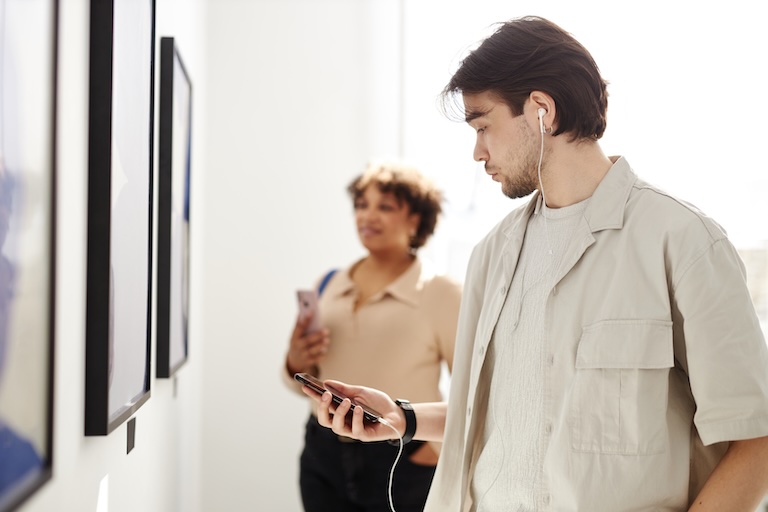 August 13, 2025
August 13, 2025
More access, stronger stories, and new revenue—without more staff
A modern audio guide on visitors’ own phones makes your collection more accessible and multilingual, smooths gallery flow, deepens engagement, and creates new moments for donations and memberships. It’s affordable, fast to launch, and easy for volunteers to maintain.
Meet visitors where they are (their own phones)
Today’s visitors expect a simple scan-and-listen experience—no queues for devices, no sanitising headsets. A web audio guide loads in seconds, works on any smartphone, and can be updated by staff in minutes.
Wins: no hardware handling, fewer bottlenecks, more listening time.
Accessibility and inclusion by default
Audio helps people who are blind or partially sighted, dyslexic, or who simply prefer listening to reading. Clear narration, transcripts, and adjustable pace make content easier to absorb for everyone, including families and school groups.
Wins: more inclusive galleries, fewer “missed” labels, better school outcomes.
Multilingual: welcome the world (and local communities)
Visitors feel seen when they can choose their language. Multilingual tracks turn a good visit into a great one and encourage word-of-mouth among tourists and diaspora communities.
Wins: higher satisfaction, more recommendations, return visits.
Storytelling that sticks
Audio frees you from the label’s word count. Share the curator’s voice, donors’ memories, makers’ methods, and the social history around an object. Short chapters (60–90 seconds) keep attention high and make complex topics approachable.
Wins: deeper understanding, longer dwell time, stronger emotional connection.
5) Smoother flow, happier galleries
Self-paced tracks and “choose your own route” options spread visitors out and reduce crowding at star objects. Families can split focus; frequent visitors can jump straight to new exhibits.
Wins: fewer pinch-points, better capacity during busy hours.
6) Gentle, timely revenue prompts
Placed at the right moments—after a moving story or at tour end—lightweight prompts can invite a tap-to-donate, join, or shop stop. Small, optional asks add up without putting pressure on staff or visitors.
Wins: incremental donations, more memberships, better shop conversion.
7) Operations: easier than you think
- No hardware fleet: no charging, loss, or repairs.
- Simple CMS: staff or volunteers can add stops, upload photos, and edit scripts.
- Offline-friendly: pre-load audio for basements and thick-walled historic rooms.
- Instant updates: fix a typo or add a new stop during lunch.
Wins: lower running costs, faster iteration, volunteer-friendly.
8) Data that helps curators (and funders)
Privacy-respecting analytics show which stops people play, where they pause, and which languages matter. Use insights to refine scripts, plan rotations, and report impact to funders.
Wins: evidence for grants, smarter programming, measurable impact.
9) “But do we really need one?” Common objections
- “Our visitors like labels.” Keep them! Audio complements labels, gives depth, and supports those who can’t or don’t want to read.
- “We don’t have staff to manage it.” Start with a pilot: 10–20 key objects, one language. Build from there.
- “Wi-Fi is patchy.” Offer pre-load and offline playback.
- “It’s expensive.” Web audio is far cheaper than dedicated devices and scales as you grow.
10) A simple 2-week launch plan
- Pick a scope: 12–20 objects that represent your voice.
- Draft scripts: 150–220 words per stop (≈60–90 seconds). Lead with a hook, explain why it matters, end with a memorable detail.
- Record: staff, volunteers, or light professional voiceover; warm, conversational tone.
- Translate (if relevant): start with your top two visitor languages.
- Set up the guide: upload tracks, titles, images; group into short trails (e.g., “Family Highlights—20 minutes”).
- Signage: QR codes at entrance and star objects; add the guide URL to tickets and website.
- Soft launch: invite members and volunteers; fix rough edges.
- Add revenue prompts: one gentle ask near the end; one optional join-the-museum moment.
- Measure and iterate: track completion rates and favourite stops; improve the rest.
11) What good looks like (mini checklist)
- Short, human, jargon-free scripts
- Consistent audio levels and clear mic technique
- Transcripts and alt text for images
- Trails by time, theme, and audience (e.g., 15-minute highlights, Kids’ detective trail)
- Subtle prompts, never intrusive
- Offline playback for signal-poor rooms
- Analytics you actually use
12) The bigger picture
A thoughtful audio guide doesn’t replace your team—it scales their voices. It turns moments of wonder into memory, and memory into support for your mission.
Your Museum Journey, Your Language.


